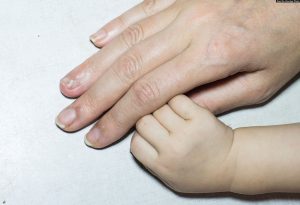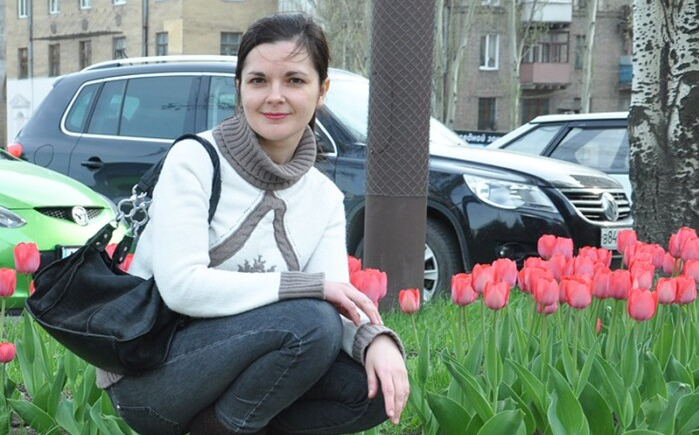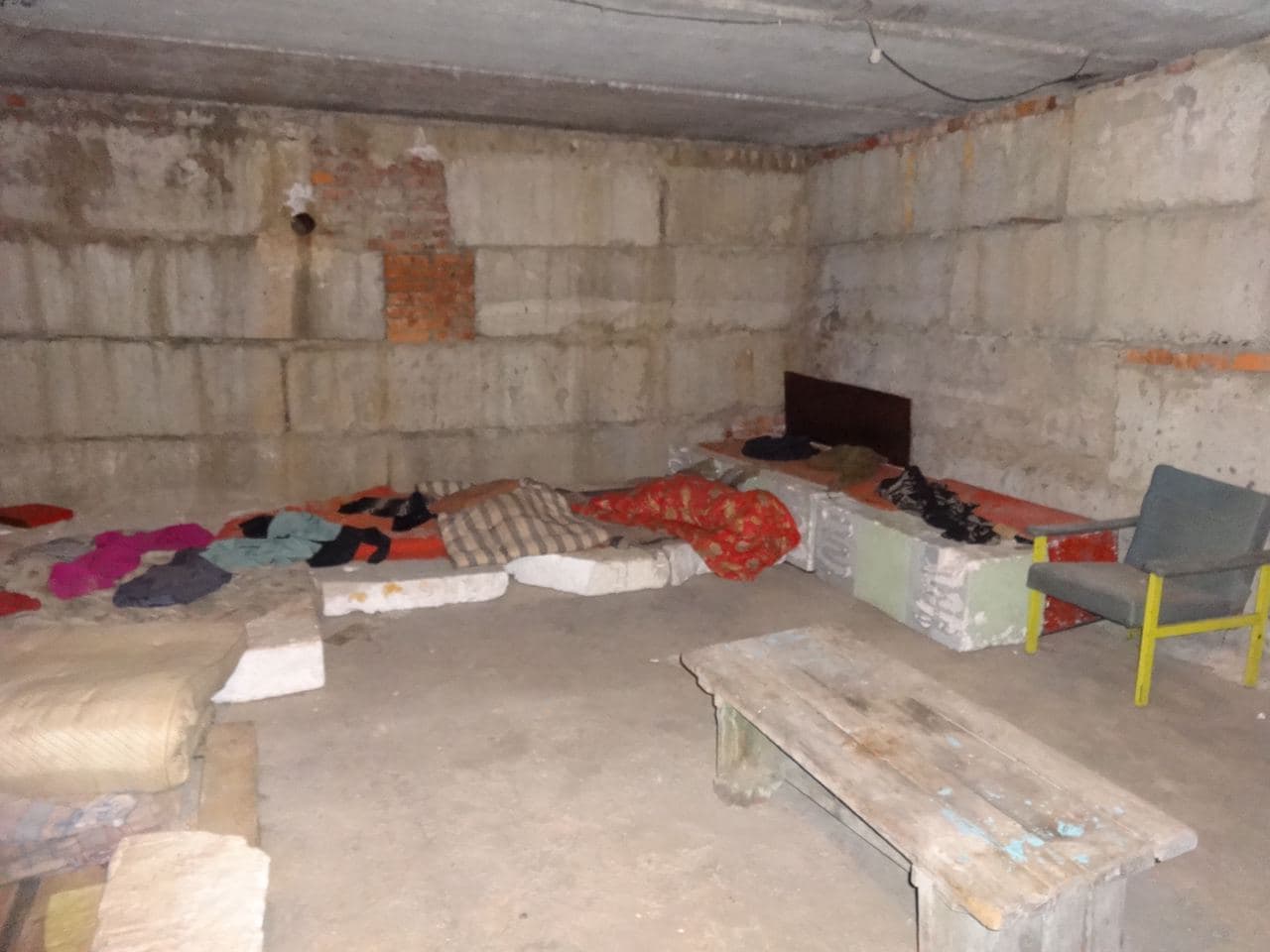Not only does Shu take photos of these people, but she also tells their stories on her website, which is constantly updated. The last prisoner exchange between Kyiv, and occupied Donetsk and Luhansk took place on December 29, 2019, so the photographer is currently negotiating photo sessions with the prisoners who recently returned home.
Among the heroes of the photo project called “After Captivity”, there are several well-known prisoners, namely artist Serhiy Zakharov, who drew caricatures
of the Russian proxy leaders and hung them on the streets of Donetsk, and Volodymyr Zhemchuhov, who lost his sight and both hands when he stepped on a landmine during a combat mission, and then was captured by Russian mercenaries. In addition, Shu tells the stories of ordinary people who were held prisoner for several hours or days. These people were not officially exchanged, but were often released thanks to a happy coincidence, relations, ransom, etc.. All of them have been forced to cope on their own with the memories and trials of their captivity.

“Captivity is not like imprisonment. There are certain rules in a prison, norms for detention, and the term of imprisonment is known to all. But, when someone is arrested and held in a combat zone where there is no judicial system and laws do not apply, the unthinkable can happen, since the person is at the mercy of those who have captured him.” states the project website.

Zoya Shu says she decided to take photos of prisoners because they represented more than just subjects for a documentary photography project:
“When I saw that there were so many people who had survived captivity, people who needed psychological help, people who searched for additional rehabilitation, and when I realized that this topic has not been well covered, I decided to do something about it. Thousands of people have lived through traumatic situations in the war zone, and I feel that the lack of attention to this problem can affect the development of the whole country. I was in Sarajevo in 2013, and saw how ordinary people continue to cope with the problems of war, even after so many years. Then, it was something distant and exotic, but now it has become our daily reality.”

- You take very unusual photos of these heroes: many of them demonstrate what happened to them during torture or during captivity. How did you manage to persuade them to tell their story? Was it difficult to persuade a man who had a swastika carved on his back to display it to everyone? These people lived through hell, so it must have been very difficult for them to talk about what they experienced.
- When I started working on this project, I tried to be as understanding as possible, to speak gently and calmly, because I had never encountered such situations. I realized that if I wanted people to open up, I’d have to be more open myself and take a step in their direction. For me, it was a transformative experience, because it was a totally different manner of communication. But, we managed to establish friendlier relations and started communicating more.

As for the man with the scar on his back, he was held captive for ten days. He knew nothing about prisoners’ rights; he didn’t know that people who’d survived captivity could try to get some kind of support from the government. We started talking; I asked him if his scar could be photographed, and he said: “Yes, of course”. When I published these photos, I told him that I wouldn’t give his full name, but he insisted on having all the information published, because he wanted others to know what had happened to him. Basically, the media only talk about official prisoner swaps... but people continue to live with their experiences. For those who survived captivity, this project has probably had a therapeutic significance. It’s also a search for justice.

- You say that some prisoners don’t know that they can receive help from the state. Does this mean that many of them are left face-to-face with their problems after they’ve been released?
- Yes. This is about civilians. Not everyone was released thanks to a prisoner exchange; some were able to pay ransom money, some were just lucky, some had outside help, some were liberated for no apparent reason… Each story is different. According to some estimates, several thousand people have gone through a period of captivity. There’s no exact data. Most of these people simply continue living and try to forget everything, or they have already forgotten everything, or perceive it as a passing stage in life. Others are forced to continue living because there’s no systematic solution to their problems.


- The prisoners are very different. There are people from different social groups, with different backgrounds, different ages, they have different experiences. Despite the fact that most of them have survived torture and captivity, each person has a story to tell. During the photo sessions, did you have the feeling that they had something in common?
- These people share a common traumatic experience that has left a very deep imprint on their organism. We all experience stress in our lives, and we know that any stressful situation requires strong resources for recovery. People, who have experienced situations of extreme violence and extreme stress, need more resources to recover. That is why they need systemic comprehensive support from the government. In addition, this situation affects society as a whole, since so many people have lived through captivity and survived the war. There are so many of them, and the trauma is very deep and very strong. We must understand this and do something about this.

- Despite the fact that it describes such traumatic experiences, it seems that your project also projects some kind of optimism. For example, Vitaliy Paraskun’s story. This priest found himself in a cold, dark cellar, where he was treated like an animal, but he found the strength to talk to the other prisoners around him, and to preach the Word of God. Later, he found the strength to leave the past behind and continue living.
- My project is not about victims, but about survivors. These people survived, and, of course, this is a positive project, but its goal is to raise awareness of the topic of trauma in our society. Of course, these are very strong people who have internal resources, even though the state doesn’t help them in any way. This is the positive side.

One of my heroes, a Spaniard, was held captive for one month. He said that it’s wrong to look at survivors in a superior and condescending way. People who have gone through such an experience don’t want to be referred to as victims; they don’t need our empathy. But, empathy seems to have almost become a ritual in our society. We believe that we should sympathize with such people, and then proceed on our way. However, people who’ve survived horrifying traumatic situations should be respected, and their opinion must be heard. They can probably make more important contributions than, for example, people who consider themselves experts in this field. In addition, these people have additional resources, they have additional values, and they shouldn’t be undervalued and categorized as victims with passive needs. They can make very positive contributions to society.

In conclusion, photographer Zoya Shu admits that this experience with former prisoners has had a huge impact on her life and work:
“After interviewing these survivors, you start talking very carefully with other people because you never know what’s behind them… this person may have lived through a terrible experience...”





